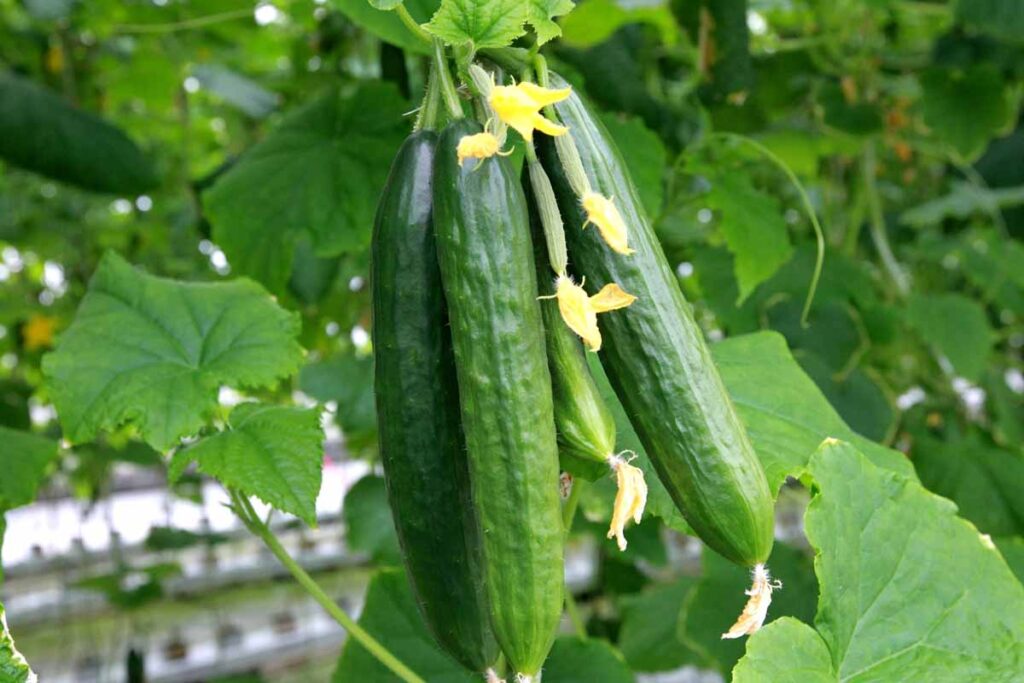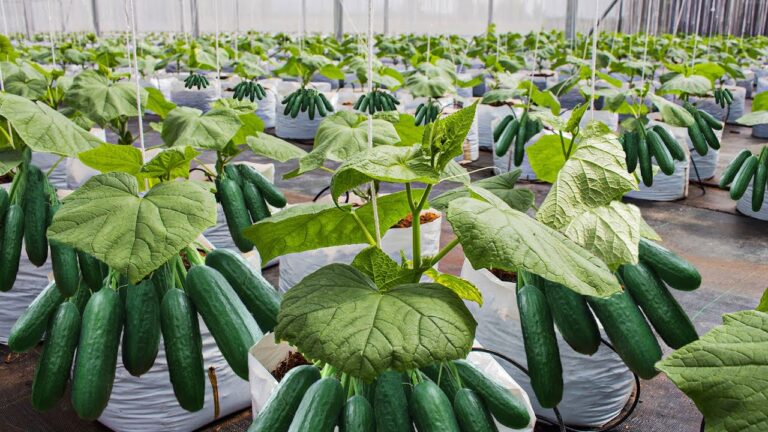Greenhouse Cucumbers and Regular Cucumbers differ in taste, growing conditions, and availability. Greenhouse Cucumbers, grown in controlled environments, offer a milder flavor, consistent texture, and are available year-round. Packed with vitamins and crispiness, they’re seedless for a hassle-free crunch.
On the flip side, Regular Cucumbers, grown outdoors, have a traditional taste with variable textures and are harvested seasonally. Understanding these distinctions helps us choose based on preferences – whether it’s the reliable, controlled environment of Greenhouse Cucumbers or the classic, seasonal appeal of Regular Cucumbers – both bringing unique flavors to our tables and gardens.
Greenhouse Cucumbers
Greenhouse cucumbers, also known as hothouse or English cucumbers, are varieties cultivated in controlled environments, typically greenhouses.
Unlike traditional field cucumbers, these are elongated, seedless, and have a thin skin. The controlled environment allows for precise management of temperature, humidity, and other growth factors.
Greenhouse cucumbers exhibit distinctive characteristics. Their elongated shape and reduced seed content contribute to a milder taste compared to regular cucumbers. The thin skin is edible, offering a delightful crunch.
The controlled environment ensures consistent quality, uniform size, and a smoother appearance, making them popular choices in both commercial and home settings.
What Are The Benefits of Greenhouse Cucumbers?

Nutritional Advantages
Greenhouse cucumbers boast nutritional benefits, providing essential vitamins and minerals. Their seedless nature enhances the crisp texture and increases the edible portion, making them a nutrient-dense option. High water content contributes to hydration, while vitamins like A and K, and minerals like potassium, support overall health.
Year-Round Availability
One significant advantage of greenhouse cultivation is the year-round availability of cucumbers. Traditional outdoor cultivation is often seasonal, limiting the availability of fresh cucumbers. Greenhouse technology allows for a consistent supply, meeting consumer demands even during off-seasons, and reducing dependence on imported produce.
Controlled Growing Conditions
Greenhouse cucumbers thrive in controlled environments where factors like temperature, humidity, and light are regulated. This controlled setting minimizes exposure to pests and diseases, reducing the need for pesticides. Additionally, it facilitates optimized nutrient uptake, resulting in cucumbers with a more predictable taste, texture, and appearance.
Regular Cucumbers
Regular cucumbers, also known as field cucumbers, encompass a diverse range of traditional varieties. These can include popular types like the American slicing cucumber or the pickling cucumber, each with its distinct characteristics.
Traditional varieties often have a more rounded shape, visible seeds, and thicker skin compared to their greenhouse counterparts.
Common traits of regular cucumbers include a firm texture, slightly bitter taste, and a thicker skin that may require peeling. The presence of seeds, while contributing to the traditional cucumber appearance, can affect the overall texture and influence culinary applications.
Regular cucumbers are often associated with the classic cucumber flavor, making them a staple in various culinary traditions.
Traditional Growing Practices
Seasonal Availability
Regular cucumbers are typically subject to seasonal cultivation, with their availability influenced by environmental conditions. They thrive in warmer temperatures and are commonly associated with late spring to early fall harvests.
Seasonal availability means that fresh, locally sourced regular cucumbers may be limited during the colder months, leading to a reliance on imported produce during off-seasons.
Outdoor Cultivation Challenges
Growing regular cucumbers outdoors poses specific challenges. Exposure to natural elements and pests can impact their cultivation. Outdoor cultivation is subject to the unpredictability of weather conditions, affecting both the yield and quality of the crop.
Pests such as cucumber beetles and diseases like powdery mildew can pose significant challenges, requiring the use of pesticides and other interventions to maintain a healthy crop.
Greenhouse Cucumbers vs Regular: Taste and Texture
Flavor Profile of Greenhouse Cucumbers
Greenhouse cucumbers, nurtured in precisely controlled environments, offer a distinct taste profile. The controlled conditions optimize factors such as temperature, humidity, and light, influencing the cucumber’s chemical composition.
This results in a milder, less bitter taste compared to regular cucumbers. The absence of extreme temperature fluctuations and exposure to environmental stressors contributes to a consistent, refined flavor that appeals to those seeking a refreshing and subtly sweet cucumber experience.
The texture of greenhouse cucumbers is a testament to the controlled conditions in which they thrive. The consistent temperature and optimal growing conditions contribute to a more uniform texture.
These cucumbers are known for their crispiness, a feature enhanced by their seedless nature. The thin, edible skin adds an enjoyable crunch, making them a preferred choice for salads, sandwiches, and snacking.
Flavor Profile of Regular Cucumbers
Regular cucumbers, grown in open fields under natural conditions, exhibit a broader spectrum of taste. Factors such as soil composition, sunlight exposure, and seasonal variations contribute to natural variations in flavor.
The taste can range from mildly sweet to slightly bitter, adding a nuanced complexity that some consumers appreciate. The presence of seeds may also influence the overall taste, providing a more traditional cucumber flavor.
Regular cucumbers are known for their traditional texture, characterized by a slightly firmer feel and thicker skin. The presence of seeds contributes to a more substantial bite, which some consumers associate with the classic cucumber experience.
The natural growth process, subject to environmental elements, contributes to the variations in texture, providing a more rustic and traditional cucumber crunch.
Nutritional Comparison Between Greenhouse Cucumbers And Regular Cucumbers
| Nutritional Components | Greenhouse Cucumbers | Regular Cucumbers |
| Calories | Lower | Moderate |
| Vitamin A | Present | Present |
| Vitamin K | Rich source | Contributing |
| Potassium | Abundant | Similar |
| Dietary Fiber | Limited (Seedless) | Moderate (with seeds) |
| Water Content | High | Moderate |
| Growing Conditions | Controlled environment | Outdoor cultivation |
| Taste and Texture | Milder, consistent | Traditional, variable |
| Special Characteristics | Seedless, consistent | Seeds, traditional |
What factors should home gardeners consider when choosing cucumber varieties?

When home gardeners are selecting cucumber varieties, several factors come into play to ensure a successful and satisfying cultivation experience.
Space and Growing Environment
Garden Size: Consider the available space in your garden. Some cucumber varieties are more compact and suitable for smaller spaces, while others may require more room to spread.
Climatic Conditions: Choose cucumber varieties that are well-suited to your local climate. Some may thrive in warmer conditions, while others are more cold-tolerant.
Cultivation Type
Determine whether you prefer bush cucumbers, which are more compact and suitable for container gardening, or vining cucumbers that spread along the ground or climb on trellises.
Cucumber Type
Slicing Cucumbers: If you primarily intend to use cucumbers for fresh consumption, look for slicing varieties. These are typically longer and have a milder taste.
Pickling Cucumbers: If you’re interested in making pickles, choose cucumber varieties specifically bred for pickling. These are often smaller and more uniform in size.
Seedless or Seeded
Seedless Varieties: Seedless cucumbers are often preferred for their convenience and smoother texture. However, they may require more controlled growing conditions.
Seeded Varieties: Traditional cucumbers with seeds may be preferred by some for their classic taste. They also provide the option of saving seeds for future plantings.
Disease Resistance
Look for cucumber varieties that are resistant to common diseases in your region. This can help ensure a healthier and more robust crop.
Harvesting Preferences
Continuous Harvest: Some cucumber varieties are known for a prolonged harvest period, providing a steady supply over the growing season.
Early Maturing Varieties: If you have a shorter growing season, consider cucumber varieties that mature quickly to ensure a successful harvest.
Flavor Profile
Consider the taste preferences of your household. Some cucumber varieties have a milder flavor, while others may have a more pronounced cucumber taste.
Companion Planting
Explore companion planting options. Cucumbers can benefit from being planted near certain companion plants that enhance growth or repel pests.
Disease and Pest Resistance
Select cucumber varieties that are resistant to common pests and diseases in your area. This can reduce the need for chemical interventions.
Personal Preferences
Ultimately, consider your own preferences and gardening goals. Whether it’s the texture, taste, or ease of cultivation, choosing cucumber varieties aligned with your preferences enhances the overall gardening experience.
FAQ
What is the difference between English cucumbers and green cucumbers?
English cucumbers, or hothouse cucumbers, differ with their longer, seedless, milder profile, while green cucumbers, the traditional variety, are shorter, have seeds, and a more pronounced taste.
Are hot house cucumbers healthy?
Yes, English cucumbers, or hothouse cucumbers, are healthy—low in calories, high in water content, and rich in essential nutrients like vitamins A and K.
What is the difference between a cucumber and a field cucumber?
“Cucumber” generally refers to traditional green cucumbers from open fields, emphasizing the outdoor cultivation method.
Which variety of cucumber is best?
The best cucumber variety depends on preferences. English cucumbers offer a mild, seedless option, while traditional green cucumbers provide a classic taste.
Are there two types of cucumbers?
Yes, broadly categorized into greenhouse (English) cucumbers and regular (field-grown) cucumbers, each with unique characteristics.
What are greenhouse cucumber varieties?
Greenhouse cucumber varieties, like “Mini” and “Long English,” are grown in controlled environments, resulting in seedless, mild cucumbers.
What are regular cucumbers called?
Regular cucumbers, grown in open fields, are often called “cucumbers” or “field cucumbers,” including types like “Slicing” and “Pickling.”
What type of cucumber is normal?
“Normal” cucumbers typically refer to traditional green, field-grown cucumbers with seeds, thicker skin, and a classic taste.
Final thoughts
In conclusion, the choice between Greenhouse Cucumbers and Regular comes down to personal preferences. If you value a milder taste, consistent quality, and year-round availability, Greenhouse Cucumbers are the go-to. On the other hand, if you appreciate the traditional flavor, varied textures, and the charm of seasonal harvests, Regular Cucumbers maybe your top pick.
Both varieties bring unique qualities to the table, catering to different tastes and gardening styles. Ultimately, whether you opt for the controlled environment of Greenhouse Cucumbers or the classic appeal of Regular Cucumbers, both promise a fresh and delightful addition to your culinary adventures and home gardens.”

